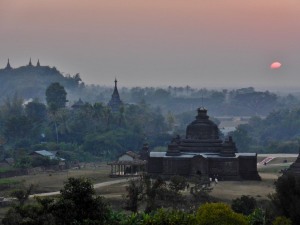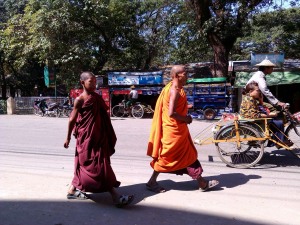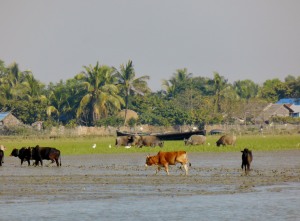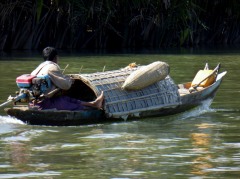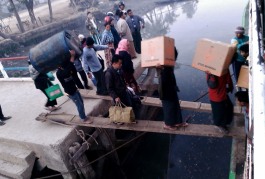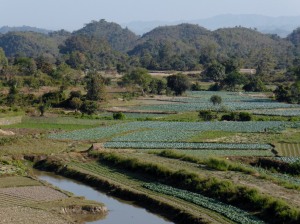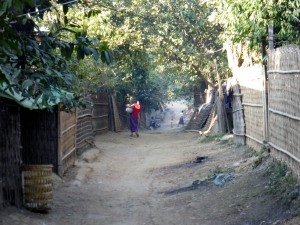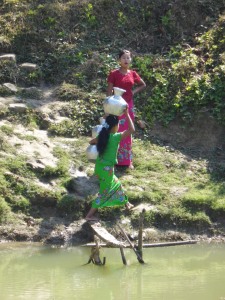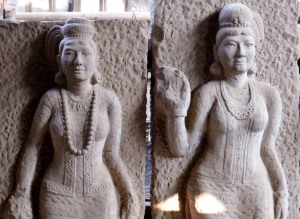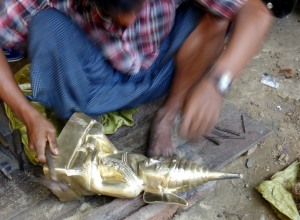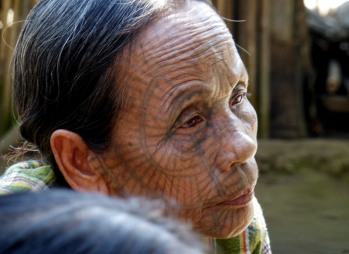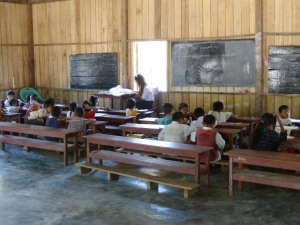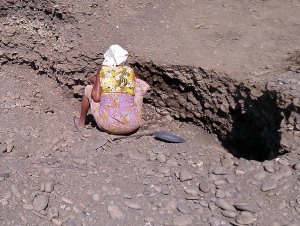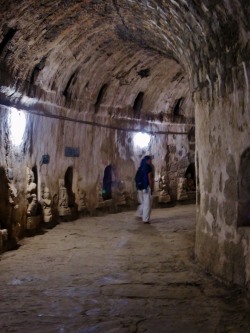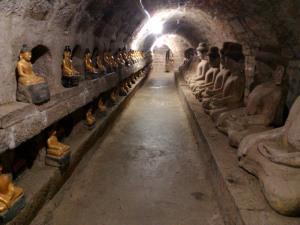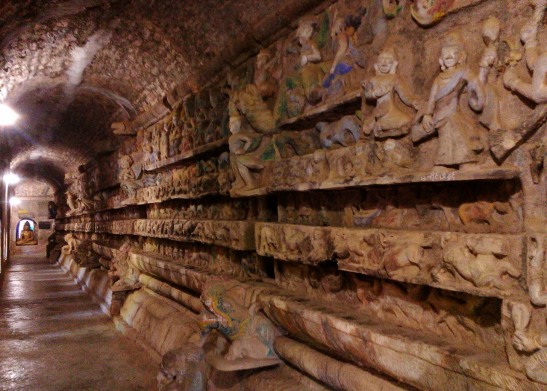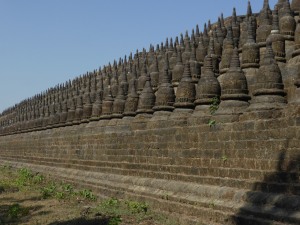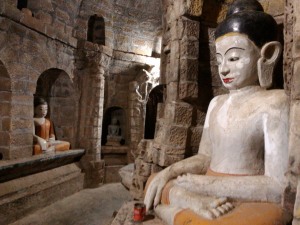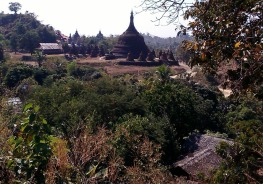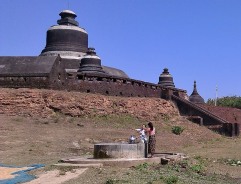MYANMAR – Rakhine State – Mrauk U and the Chin Villages
We decided to pass on Mandalay, missing a chance to round out Myanmar’s big four destinations by skipping Mandalay and heading northeast to Rakhine State for a taste of more temples at Myanmar’s second best archaeological site at Mrauk U while taking a quick foray up the Kaladan River to the some villages of Chin State.
It took a day to get to Sittwe on the Andaman Sea and an overnight stay to catch a five hour boat ride up the river to Mrauk U. Sittwe may have its charms but they are not readily apparent, at least in the few hours we gave it.
Other than the armed guards in front of the towns seemingly deserted main mosque there was little sign of the nationalist Buddhist’s attacks on the city’s Muslims a couple years back although some casual comments made to us makes it clear that relations are nowhere near mended. It is a grim reminder that all religions, even Buddhism, seem to be prey at times to bigotry, intolerance, and fear that can break into open riots.
The boat up the river to Mrauk U spent most of its time in the wide Kaladan estuary, passing river traffic moving up and down river and plying past broad plains of now harvested rice fields lined with water buffalo contentedly munching on grass in their off season with no paddies to plow. In a place with few roads the river is the lifeline. After hours the boat took a side channel up one of the five rivers of Rakhine state, the banks closed in, and we plowed towards the foothills of the Shan State. Pulling into the pier at Mrauk U there was a flurry of activity of loading and unloading people and the huge bundles of goods they had brought from the capital.
Mrauk U, meaning “monkey egg” (based on the tale of monkey presenting two eggs of a peahen to the Arhat Tissa, an omen that a great city where Buddhism would flourish would arise here) is little more than an overgrown town.
But the area saw the rise and fall of three great kingdoms over the last 2000 years, and the last, from the 15th to the 18th centuries, was a major power in the area, its fleets commanding the Bay of Bengal and its ports transiting the goods between Southeast Asia, India, the Middle East, and Europe. Prints and paintings made by Portuguese and Dutch traders and missionaries attest to its importance.
This kings of this land that they called Arakan built the temples that are the major draw for the few tourists that come here. But the town and its hinterland, extending up river into the Chin State is as good a reason to come. If Inle Lake provided a taste of a fading rural Myanmar, Mrauk U fills that bill even more so.
When we went to the most famous of the temples the obligatory sign in book (this is still a semi-militarized area after the troubles earlier in the decade) listed only fifteen foreign visitors the previous day. There are hopes for an economic shot in the arm from tourism but so far that seems to be more of a wish than a fact.
The main drag is just a few blocks long and except for a few tourist gewgaws in some of the shops it is basically the market town for the area. Foreigners are clearly the object of curiosity among the young while their elders are mixed in their reaction, some overtly friendly while others pass with a stone faced look that is uninterpretable.
Women carry water on their heads from the reservoirs scattered around town, filled during the rainy season and now drawing low. Road crews repave roads by hand, meticulously placing rocks for the bed one at a time. And ironically, despite its undeveloped rural character, the air here is the worst we have encountered in Myanmar. The little vehicular traffic churns up huge clouds of dust from the mostly unpaved roads and everybody cooks using wood so that each morning and evening at meal prep time the town is buried in a cloud of wood smoke that can be choking.
Tiny neighborhood stalls sell a few goods like soap and soda and many crank out betel nut chews, little leaf wrapped packets of chopped nut, lime, and a selection of other flavorings. We tried it and there seems little chance of it catching on elsewhere in the world but here as in all of Myanmar betel nut is ubiquitous. As you walk you are constantly dodging the chewers ejecta, and when a habitual chewer smiles it is tempting to cringe a little at the red stained stubs of their teeth.
Mrauk U boasts a couple of dominant home industries like stone carving. No doubt the descendants of the stone masons and carvers who built the temples of Mrauk U centuries ago, they now chisel the local sandstone into decorative architectural friezes and moldings for use in the area and shipped around Myanmar. Many of the patterns are inspired by or lifted directly from the temples that are still scattered in the midst of the town and its surrounds.
There are also many bronze casters making mostly Buddha and other votive images for local and national consumption. They use lost wax methods and their feed metal is an astonishing variety of brass and bronze scraps, melted over small charcoal fires. But most of the work seems to be filing and grinding to finish rough castings, all done with hand files and burrs. A favorite product that you can see on the dashboards of many cars is a casting of the Rakhine State “mascot,” the byala, a mythological hybrid creature that is also carved on many temples. It is a composite of nine animals with the crest of a dragon, trunk of an elephant, the horn of a rhinoceros, the eyes of a deer, the ears of a horse or elephant, the tongue of a parrot, the feet, face and mane of a lion, and so on.
With another boat ride up the Lemro river to the outlying villages of Chin State we got an even closer look at rural Myanmar – there are at least a couple roads in and out of Mrauk U but none a couple hours upriver. In the ethnic hodgepodge that is Myanmar the Chin are famous for their women whose faces are covered with tattoos.
The story is that the Chin women were renowned for their beauty, so much so that the kings of Mrauk U kept carrying them away as brides, so the leader of the Chin decreed all girls at age nine have their faces tattooed to take away their allure. The practice was banned 57 years ago so only elderly Chin women still bear the tattoos. Different areas used different patterns like stars or arrays of dots but the villages we visited were spider clan so the women have a web like pattern on their faces. Today they make a meagre living selling their hand woven shawls to the handful (literally) of tourists that make their way the few hours up river each day.
These are tiny villages of perhaps one or two hundred people, some desperately poor, all without any of the services we take for granted. Only one had a school with all grades in a single room. Sraw May Village’s new project, which we were tapped for a contribution (willingly) is to build a monastery so that they can have access to the services that these Buddhist institutions provide like coming of age, marriage, and funeral services. If you make your way here remember to find Sraw May Village and contribute to their Buddhist house.
Besides some fishing and subsistence farming and husbandry the only real industry and source of cash income is ironically rocks – all up and down the Lemro river people are pulling rocks out of the river and its banks and packing them into boats to haul downriver to Mrauk U where they are loaded by hand into trucks to supply road and building construction in Mrauk U. Some of the operations have a gas powered pump dredges and screens but for the most part people dig them out of the banks with a iron rod or piece of rebar, harvesting a ton or two a day. The going rate we were told was 12,000 kyat, about $12, per cubic meter.
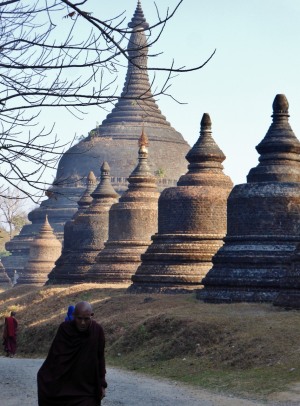 But of course the reason most tourists, both Burmese and foreign, com here are for the five hundred year old temples. After Bagan this is Myanmar’s second most famous archaeological site but other than a common Buddhist faith they are different in every way, separated in time, by culture, by construction, and by “feel.”
But of course the reason most tourists, both Burmese and foreign, com here are for the five hundred year old temples. After Bagan this is Myanmar’s second most famous archaeological site but other than a common Buddhist faith they are different in every way, separated in time, by culture, by construction, and by “feel.”
Bagan is made of brick and although not light and airy they feel that way compared to Mrauk U’s massive stone constructions. And while Bagan is most impressive outside with its thousands of chedis jutting up over the plain, Mrauk U’s temples are more austere on the exterior but hide fascinating chambers within.
Passing through the door of Htuk Kant Thein you enter a heavy stone passageway, lined with 146 niches containing Buddha images and flanked by reliefs of the people who dedicated the images kneeling in supplication and adoration. Some of these worshipers look formulaic but many are individualized, decked out in the dress of the time (about 1575) and detailed enough that they have been used to compile a catalog of the “forty hairstyles of Mrauk U.” Within this rectangular stone mass this passage is a gently curving spiral in plan so it isn’t until you reach the final, very atmospheric terminal chamber that you realize you have to backtrack to leave.
A couple hundred yards away Shite Thaung has the same narrow galleries but instead of being spiral in plan it has a series of nested rectangles, the outermost of which is covered floor to ceiling with high relief stone carvings, with a mix of subjects – mythological figures of ogres, giants, and the byala, scenes from local legend, illustrations of the life and past lives of Buddha, images from the Hindu pantheon, and purely decorative and even whimsical representations of men and beasts. All of the way around this gallery three stone shelves lined with over three thousand little reservoirs for oil lamps. The effect of the high relief, highly colored stone carvings lit by these oil lamps can’t be imagined.
The third of the most famous temples is Ko Thaung, what many call Mrauk U’s Borobodur (in Indonesia), clad with hundreds of stone chedis, although it is Borobudur’s little brother, small in comparison to that stone mountain. It is called the temple of 80,000 images and although its galleries are literally lined with images, we were hard pressed (although we didn’t count) to come close to 80,000. But it is impressive nonetheless.
Small compared to its big cousins is Andaw temple, octagonal in plan with a single narrow gallery around a central pillar that is decked out in elaborate stone carving. Petite but gorgeous it has an undeniable presence of place.
All of these three and the many other temples of Mrauk U are still active sites of worship among locals and many of the Burmese tourists come to make offerings to the famous and venerable images housed within. In fact for the many Burmese this is not an archaeological but a pilgrimage site.
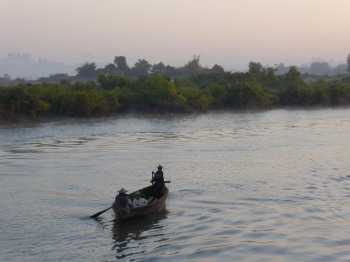 The trip back down river to Sittwe began our progress back to Yangon and the marked the beginning of the end of our time in Myanmar. This has been as special to us, a place of many memorable sights and experiences, a fitting finale to both Asia and Southeast Asia. But now it is time to jump another ocean and begin a new chapter in pour trip. We are headed next for the Middle East. Our first stop is Egypt.
The trip back down river to Sittwe began our progress back to Yangon and the marked the beginning of the end of our time in Myanmar. This has been as special to us, a place of many memorable sights and experiences, a fitting finale to both Asia and Southeast Asia. But now it is time to jump another ocean and begin a new chapter in pour trip. We are headed next for the Middle East. Our first stop is Egypt.
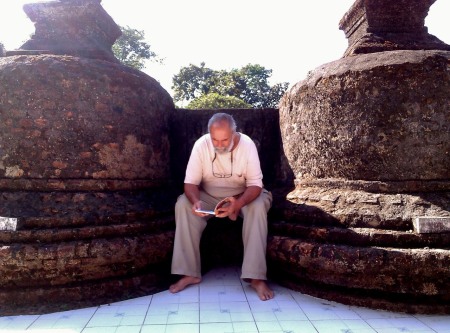
Scott reading about the temple. You have to take your shoes and socks off before entering a temple area.
